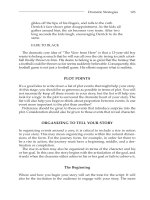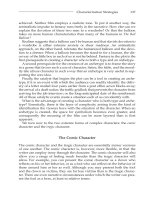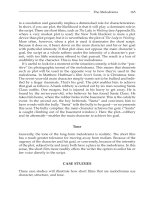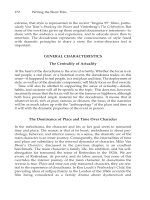Tài liệu Writing the short film 3th - Part 21 pdf
Bạn đang xem bản rút gọn của tài liệu. Xem và tải ngay bản đầy đủ của tài liệu tại đây (131.06 KB, 7 trang )
view. In John Osborne’s screenplay of Tom Jones, the main character is gen-
erally a conventional first-person main character but occasionally becomes a
second-person main character: at those moments, he turns directly to the
screen and addresses the audience.
The same technique of using the main character to narrate is found in
Stanley Kubrick’s A Clockwork Orange. Whether it is a direct, onscreen sec-
ond-person appeal to the audience or the use of the main character as an
offscreen narrator, the result is to alter our relationship with the main char-
acter, from one of involvement to one where we step out of the relationship
and reflect upon it. This distancing device serves to generate empathy for
Alex in A Clockwork Orange.
5
In Tom Jones, however, the technique does
nothing but draw attention to itself. In this sense, the Brechtian device of
alienating us from the character in order to reflect upon the subtextual
political or social commentary does not work. It is a style that is counter-
productive to the dramatic elements of the story, much as the third-person
position is.
The second-person position, then, is a risk for the writer. The danger is
that the writer can fracture our relationship with the story. The gain can be
that the writer succeeds in commenting upon the character, his or her behav-
ior, and his or her view of society.
The best approach to the main character is to use the first-person position,
in which the character is in the middle of the story. Events happen to the
character. Barriers exist in the story that challenge the character’s goals. In
this classical situation, the position of the character best serves the narrative
purpose of the film script, and the writer can take advantage of the mechan-
ics of conflict, polarities, and a rising action in order to engage the viewer
most effectively in the screen story.
The Main Character and Secondary Characters
The main character’s position in the story is only one issue of positioning
you will have to consider. The second concern has to do with the positioning
of the secondary characters in relation to the main character. This is crucial
because only through interaction with the other characters does the main
character move through the plot. The rungs of the dramatic ladder are, in a
sense, built with the secondary characters. The issue for the writer, then, is
how to deploy the secondary characters for maximum impact in the story.
Given the issue of scale in the short film, writers employ fewer secondary
characters than in the long film. The amount of time devoted to developing
the secondary characters is also far less. Although this may mean dispro-
portionate reliance on stereotypes for the secondary characters, a more pro-
ductive approach is to relate the secondary characters to their functions in
130 Writing the Short Film
Ch11.qxd 9/27/04 6:08 PM Page 130
the plot of the film. They have specific purposes in the plot, so complex char-
acterization is far less important in their case.
In this sense, the secondary characters may be considered catalysts for the
plot. Generally, there are two types of secondary characters: those who pro-
pel the main character toward his or her goal, and those who stand as barri-
ers to the achievement of that goal. In Incident at Owl Creek, the Union
soldiers are clearly barriers to the main character achieving his goal. His wife
is also a secondary character, but one who helps move the main character
toward his goal.
The Main Character and the Antagonist
In the longer film, the relationship of the main character to the antagonist is
used to create a heroic dimension in the main character. The greater the
adversary, the greater the hero. However, heroic action is less credible in the
short film, because of its scale. Consequently, the antagonist has to fulfill
other narrative goals. The antagonist is the principal barrier to the main
character as presented in the plot. The characterization of the antagonist,
however, is not used to amplify the character of the protagonist. The rela-
tionship is no less important than it is in the long film, but by necessity it is
different.
What is the narrative goal of the antagonist? The antagonist must provide
a level of opposition to the main character that makes his or her goal diffi-
cult to achieve. To illustrate, let’s take a look at the great student film by
George Lucas, THX 1138. The main character in this futuristic film is a
human being (played by Robert Duvall) who is trying to escape his life as a
drone in an underground world controlled by technology. In the main char-
acter’s particular journey, there is no one character who fulfills the role of
antagonist. Rather there is a plethora of control devices, computer-driven
and machine-operated. In this world, computers, as an expression of tech-
nology, are the enemies of human beings. As a group, they function as the
antagonist of THX 1138. They are the masters from whom the main charac-
ter is trying to escape.
In the plot of the film, the difficulty of mastering the computers, because
of the scope of technology they can call upon, makes it seem almost impos-
sible for the main character to escape. They oppose all forms of humanness.
The antagonists require total submission by the main character; the protag-
onist requires freedom from the tyranny of the machines. Here the classic sci-
ence fiction struggle between humanity and technology works, because the
protagonist–antagonist relationship is at the very core of the dramatic idea.
Short films work best when the protagonist–antagonist relationship drives
the plot of the screen story.
Characterization Strategies 131
Ch11.qxd 9/27/04 6:08 PM Page 131
CHARACTERIZATION
The full range of physical and behavioral characteristics should be employed
to develop your story. The physical looks of character can help. Height,
weight, age, gender, together with cultural and professional characteristics,
flesh out the look of a character. The more specific you can be about the char-
acter, the more likely those qualities can be helpful in your story.
If your story concerns peer relationships, the emphasis on appearance
becomes very important. Recall the young African-American boy in Adisa
Lasana Septuri’s The View From Here, described in the last chapter. The fact
that the boy has a limp and that the other boys are playing football presents
a situation where the main character has a physical impediment to his being
accepted by his peer group.
We can imagine other stories where the physical characteristics of the
main character are central to the story. For example, let’s imagine a story of
a first-time director who gets his chance when his mentor is fired. This story
is vitalized by the youth of the main character and his relationship with the
older mentor. Another story of powerful forces in place to oppose the main
character might be one of the (physically) shortsighted bureaucrat who
begins to have visions of a new way of doing business. Here rigidity and
imagination are key physical elements.
Behavioral characteristics can be as important as physical ones. In The
Silence of the Lambs, Hannibal Lechter (played by Anthony Hopkins) is a bril-
liant, but insane, psychiatrist who is a great danger to his patients. The
behavioral quality of madness in a man who society especially expects to be
sane is an excellent example of how behavioral characteristics can be used in
a dramatically dynamic manner.
Behavior needn’t be as extreme as that of Hannibal Lechter. It can be less
obvious. Here, introductory psychology courses become useful. In a recent
classroom discussion, students voiced considerable dissatisfaction about a
character in Joe Eszterhas’s Music Box. The problem was that the character
was a good father and grandfather and seemingly a good citizen of his
adopted country. He was also tremendously fit for a senior citizen. The flaw
was that he had been a Nazi collaborator in Hungary and had killed ruth-
lessly. The students were dissatisfied that the character in the screen story
did not own up and confess his past to his own daughter, the protagonist of
the story, who defends him legally and emotionally until the evidence
becomes irrefutable.
How could the character lie so deftly, even to his own daughter? The
answer is that the behavior he exhibits is that of a sociopath. He believes in
all sincerity what he says—but in the next breath he can be caught up in a
lie, which he will deny with indignation. What the students were confronted
with in this character was a behavioral characteristic—lying—that was right
132 Writing the Short Film
Ch11.qxd 9/27/04 6:08 PM Page 132
at the character’s dramatic core. Without it, the plot and the main character’s
dilemma would have been far less interesting.
Behavioral characteristics run the full gamut of human behavior. They
require that writers be sufficiently observant to use these characteristics for
effect.
In both physical and behavioral characterizations, writers tend to use
extremes. Extremes are not only more useful dramatically, they are also more
memorable for the audience. We are gripped by extremes for an obvious rea-
son: they are more sensational than middle-range qualities. Film stories are
extremely well suited to the sensational.
Singular Qualities of Character
The behavioral and physical qualities of characters are important dimen-
sions. However, they do not necessarily link character to goal. Here a sense
of purpose is necessary. It is critical that writers link the character to a goal
powerfully, in order to animate the plot.
Different writers will speak of intentional or energized characters. It doesn’t
matter which term you use. What is important is that there be a palpable
internal quality that pushes your character in a particular direction. This
drive is as important to your story as the dominant behavioral or physical
qualities you have given your character. The drive is the fuel for the plot.
Without it your character is passive, acted upon rather than reacted to. A pas-
sive character can work in a short film, but by choosing such a character, you
flatten the conflict and position your character as much as an observer as a
participant. The result can be counterproductive in dramatic terms. The
active, obsessed main character is more useful in the narrative. Once the plot
begins, there is a natural tension between plot and character that will carry
the audience easily through the story.
Drawing Out the Character
Writers may use several other devices to make a character more vivid for an
audience. The quality most often used to engage us with the character is
humor. Whether the character uses humor to deal with his or her situation
or whether the humor arises from the character’s response in a situation,
humor plays a critical role.
A second device is to allow the character to step out of his or her public
self in an opportunity for private revelation. While the audience primarily
sees the character in action in the world, the writer can introduce the private
dimension by putting the character into a vulnerable situation. We expect a
Characterization Strategies 133
Ch11.qxd 9/27/04 6:08 PM Page 133
particular response from the character based on our experience of the char-
acter so far. If, instead, we see a vulnerable or more private, less-anticipated
response or side to the character, the writer has succeeded in setting up the
kind of paradox that yields sympathy for the character. We feel the character
has shared a private moment with us, the viewers; the relationship between
character and viewer is thereafter transformed.
A third device writers use to draw us into a character is the role played by
the antagonist. The more powerful the antagonist’s resistance and power, the
more likely we will empathize with the plight of the main character. All of
us have had goals thwarted by people or events. We understand the position
of the main character, and we will empathize with him or her. It is criti-
cal that the character try to move toward his or her goal, but it is just as critical
that the writer draw us into the character’s struggle.
The Importance of Research
It should be clear by this point that the writer not only must have a clear
understanding of the craft of writing, but also should be a student of human
behavior. To understand behavior is to be able to use action purposefully in
a story. We are not suggesting that you rush off and do a Ph.D. in psychol-
ogy. We are, however, suggesting that you become curious about human
behavior.
We recommend that you make notes and observations of behavior.
When you observe a young child pinching a dog, speculate as to why. You
don’t have to be right about the reason, but you should formulate a rea-
son that makes sense to you. Why does your doctor write prescriptions
with a fountain pen? Why does the grocery clerk double-check the
punched-in prices and the bagged groceries? Why does the professor
arrive late every week for class? Why does the surgeon doze off as soon as
he sits down at lunch?
The questions are endless, and only by observing, asking, and under-
standing will you begin to be able to employ human behavior characteristics
in a dramatic way. The key here is research. It doesn’t matter if the script you
are working on is a work of fiction. The characters in your story have to
attain a certain credibility, and so your powers of observation will be called
upon to make the characters interesting and believable.
Your research can be observational or based on others’ observations and
conclusions. Whether you depend on the library or the lunch bar as your
research center, the key is to use those resources to help your storytelling. If
you are open to human behavior, your stories will improve markedly.
How much research is enough? Put it this way: when it comes to human
behavior, we are all students always. There is never enough information.
134 Writing the Short Film
Ch11.qxd 9/27/04 6:08 PM Page 134









